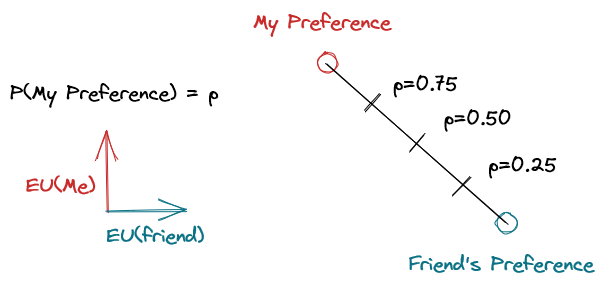It's almost a rule that as soon as you have a "utility of possible outcomes" plot like this:

You must then say "and by randomly choosing between the outcomes, we can achieve any intermediate outcome in terms of utility within the convex hull of these points" resulting in a plot like this:

Cool, I've done a linear interpolation before, seems reasonable. Plus, convex hulls are super nice to work with. But all models are imperfect - how accurate is this convex hull idea in practice?
Three stories
- I like to plan ahead, whereas my friend values chaos and unpredictability. When we want to go to a restaurant, they're a big fan of the whole "lottery between your first preference and my first preference" idea.
- If we're meeting at 7PM and the lottery happens at 7AM that's long enough to plan, so I don't mind.
- If we're meeting at 7PM and the lottery happens at 6:59PM, I am a little annoyed - I might even prefer my guaranteed second preference over my uncertain first preference.
- The "standard model" for what the outcome space looks like before picking is something like this:

- I'm a CEO managing a business undergoing a possible merger. The more uncertain the deal is, the more all of my projects are disrupted. I might be fine walking into the final meeting with a 99% or 1% chance of success, but I would be quite stressed if the numbers were 90% or 10%.
- I'm a computer, beep boop. I've been modelling deterministic systems all day long. Someone has just asked me to model something probabilistic, and now I need to learn around 70 years of research to not be overwhelmed by the state space explosion.
My point is that in practice the mapping from lottery probability and outcome utilities to lottery utility is probably not . I wonder if it's occasionally not even close. I would expect the "lottery closure" of the three outcomes above to look something like this:

I'm pretty darn sure I'm not the first person to think about this, so: how big an issue is this when thinking about things like bargaining solutions, or stochastic Nash equilibria?